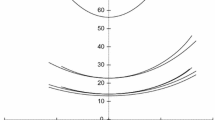Abstract
In this paper the growth curve model, with the data correlated according to uniform structure, is considered. It represents a useful statistical model for a variety of areas. Our aim is to present various estimators of unknown variance parameters and compare their statistical properties. In the first part the review of known results for different estimators of \(\rho \) and \(\sigma ^2\) and their properties is given. The aim is to compare and order these estimators based on biasedness and mean square error.





















Similar content being viewed by others
References
Chaganty NR (1997) An alternative approach to the analysis of longitudinal data via generalized estimating equations. J Stat Plan Inference 63:39–54
Chaganty NR (2003) Analysis of growth curves with patterned correlation matrices using quasi-least squares. J Stat Plan Inference 117:123–139
Golam Kibria BM, Safiul Haq M (1999) The multivariate linear model with multivariate t and intra-class covariance structure. Stat Pap 40:263–276
Hu J, Liu F, Ejaz Ahmed S (2012) Estimation of parameters in the growth curve model via an outer product least squares approach for covariance. J Multivar Anal 108:53–66
Lee JC (1988) Prediction and estimation of growth curves with special covariance structures. J Am Stat Assoc 83:432–440
Ohlson M, Von Rosen D (2010) Explicit estimators of parameters in the growth curve model with linearly structured covariance matrices. J Multivar Anal 101:1284–1295
Potthoff RF, Roy SN (1964) A generalized multivariate analysis of variance model useful especially for growth curve models. Biometrika 51:313–326
Rusnačko R (2011) Equivalence of Ohlsons and eulas approach to uniform correlation structure in the growth curve model. Forum Stat Slovacum 7:199–206
Rusnačko R (2014) Estimators of unknown parameters in the growth curve model with the uniform correlation structure based on different estimators of variance matrix. Coll Biom 44:5–23
Rusnačko R, Žežula I (2015) Connection between uniform and serial correlation structure in the growth curve model. Metrika. https://doi.org/10.1007/s00184-015-0549-5
Wu X, Liang H, Zou G (2009) Unbiased invariant least squares estimation in a generalized growth curve model. Indian J Stat 71:73–93
Ye RD, Wang SG (2009) Estimating parameters in extended growth curve model with special covariance structures. J Stat Plan Inference 139:2746–2756
Žežula I (1993) Covariance components estimation in the growth curve model. Statistics 24:321–330
Žežula I (2006) Special variance structure in the growth curve model. J Multivar Anal 97:606–618
Acknowledgements
The support of the grant VEGA MŠSR 1/0344/14 and VVGS-PF-2016-72616 is kindly announced.
Author information
Authors and Affiliations
Corresponding author
Appendix
Appendix
Proof of Lemma 1
-
1.
\(E({\hat{\rho }}_{M})-\rho =\frac{-(1+(p-1)\rho )(1-\rho )}{(p-1)[np-r(X)((p-r(Z))\rho +r(Z))]^{3}} \times \)\(\times [[(p-r(Z))r(X)n^{2}p^{2}-2(p-r(Z))r(X)^{2}npr(Z)+r(X)^{3}r(Z)^{2}(p-r(Z))]+\)\(+[-2(p-r(Z))^{2}r(X)^{2}np+2(p-r(Z))^{2}r(Z)r(X)^{3}+2n^{2}p^{2}(p-1)-\)\(-2p^{2}nr(X)(p+r(Z)-2)+2p^{2}r(X)^{2}(r(Z)-1)]\rho +[(p-r(Z))^{3}r(X)^{3}]\rho ^{2}]\) The formula is negative in case when \(\rho >0.\) Thus, let us look at the case when \(\rho <0.\) It can be shown that \(\frac{-(1+(p-1)\rho )(1-\rho )}{(p-1)[np-r(X)((p-r(Z))\rho +r(Z))]^{3}}\) is always negative. This formula is multiplied by convex function. This function has a minimum value \(c-\frac{b^{2}}{4a}\) at point \(-\frac{b}{2a},\) where \(a=(p-r(Z))^{3}r(X)^{3}, b=-2(p-r(Z))^{2}r(X)^{2}np+2(p-r(Z))^{2}r(Z)r(X)^{3}+2n^{2}p^{2}(p-1)-2p^{2}nr(X)(p+r(Z)-2)+2p^{2}r(X)^{2}(r(Z)-1)\) and \(c=(p-r(Z))r(X)n^{2}p^{2}-2(p-r(Z))r(X)^{2}npr(Z)+r(X)^{3}r(Z)^{2}(p-r(Z)).\) If \(n>\frac{r(X)}{p(p-1)}[p^{2}(r(X)-1)-p(2r(X)r(Z)+1)+r(X)r(Z)^{2}]\) the x value of vertex is not in feasible region, thus we are interested only in the opposite case. In such a case the formula can be positive for some choices of model constants.
-
2.
\(E({\hat{\rho }}_{MU})-\rho =\frac{2(1+(p-1)\rho )(1-\rho )((p-1)(r(X)r(Z)-np)\rho +r(X)(p-r(Z)))}{p^2(n^2(p-1)-n(p+r(Z)-2)r(X)+(r(Z)-1)r(X)^2)}\) It can be shown that the denominator is always positive. The numerator has zero points \(-\frac{1}{p-1}\), 1 and v, where \(v=-\frac{r(X)(p-r(Z))}{(p-1)(np-r(X)r(Z))}\in \left( -\frac{1}{p-1};0\right) .\) Thus, the bias is positive for \(\rho \in \left( -\frac{1}{p-1}, v \right) \) and negative for \(\rho \in \left( v, 1\right) .\)
-
3.
\(E({\hat{\rho }}_{O})-\rho =\frac{2(1-\rho )(1+(p-1)\rho )}{p^{2}(p-1)(n-r(X))} ((p(p-1)+r(X)(p-r(Z))(p-r(Z)-2))\rho -r(X)(p-r(Z))(p-r(Z)-2))\) Simple computation shows that formula for bias has zero points \(-\frac{1}{p-1}\), 1 and w, where \(w=\frac{r(X)(p-r(Z))(p-r(Z)-2)}{p(p-1)+r(X)(p-r(Z))(p-r(Z)+2)}\in (0;1).\) The bias is positive for \(\rho \in \left( -\frac{1}{p-1}, w \right) \) and negative for \(\rho \in \left( w, 1\right) .\)
-
4.
\(E({\hat{\rho }}_{U})-\rho = -\frac{2\rho (1-\rho )(1+(p-1)\rho )}{(n-r(X))p}\) Zero points for this formula are \(-\frac{1}{p-1}\), 0 and 1. So we can see that under assumption \(n>r(X)\) and \(\rho >-\frac{1}{p-1}\) the bias is positive only for \(\rho \in (-\frac{1}{p-1}, 0)\) and it is negative for \(\rho \in (0,1).\)
Proof of Lemma 2
this is always negative if \(n>r(X),\)\(p>r(Z)+2\) and \(\rho >-\frac{1}{p-1}.\)
This formula is always negative if \(n>r(X),\)\(p>r(Z)+2\) and \(\rho >-\frac{1}{p-1}.\) Simple computation shows that \([n^{2}(p-1)-n(p+r(Z)-2)+(r(Z)-1)r(X)^{2}]\) is always positive. \(\square \)
Proof of Lemma 3
This function is increasing, always negative under the assumption \(p>r(Z)+2.\) It assumes maximum for \(\rho =1\) and this maximum is zero. Thus, the U-estimator is better than O-estimator.
where \(c=np(p-1)-r(X)r(Z)-r(X)p^{2}+r(X)2p.\) It is obvious that the numerator is always positive. Discriminant of denominator is always negative and for the leading coefficient it holds: \((p-1)^{2}(np-r(X)r(Z))>0,\) so that the denominator is a positive convex function for \(\rho \in \left( -\frac{1}{p-1}, 1\right) .\) The whole fraction is therefore always positive. Thus, MU-estimator is better then U-estimator. \(\square \)
Rights and permissions
About this article
Cite this article
Kopčová, V., Žežula, I. On intraclass structure estimation in the growth curve model. Stat Papers 61, 1085–1106 (2020). https://doi.org/10.1007/s00362-017-0973-x
Received:
Revised:
Published:
Issue Date:
DOI: https://doi.org/10.1007/s00362-017-0973-x




